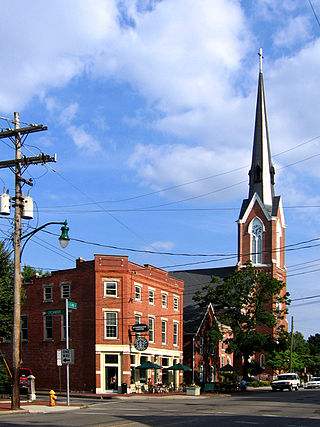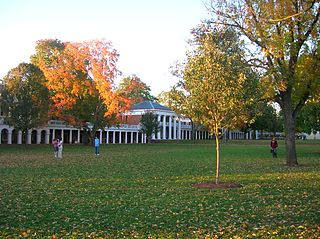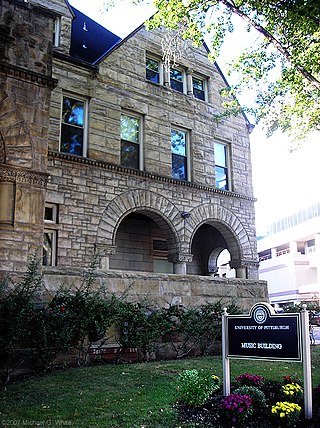
Huntington is a city in Cabell and Wayne counties in the U.S. state of West Virginia. The county seat of Cabell County, the city is located at the confluence of the Ohio and Guyandotte rivers. Huntington is the second-most populous city in West Virginia, with a population of 46,842 as of the 2020 census. Its metro area, the Huntington–Ashland metropolitan area, is the largest in West Virginia, spanning seven counties across three states and having a population of 376,155 at the 2020 census.

German Village is a historic neighborhood in Columbus, Ohio, just south of the city's downtown. It was settled in the early-to-mid-19th century by a large number of German immigrants, who at one time comprised as much as a third of the city's entire population. It became a city historic district in 1960 and was added to the National Register of Historic Places in 1974, becoming the list's largest privately funded preservation district, and in 2007, was made a Preserve America Community by the federal government. In 1980, its boundaries increased, and today it is one of the world's premier historic restorations.

The Lawn, a part of Thomas Jefferson's Academical Village, is a large, terraced grassy court at the historic center of Jefferson's academic community at the University of Virginia. The Lawn and its surrounding buildings, designed by Jefferson, demonstrate Jefferson's mastery of Palladian and Neoclassical architecture, and the site has been recognized as an architectural masterpiece in itself. The Lawn has been designated a U.S. National Historic Landmark District, and is part of a UNESCO World Heritage Site along with the original buildings of the University of Virginia and Monticello, Jefferson's nearby residence; this designation is due to the site's architectural and cultural significance.

Huntington, West Virginia's central business district is located to the south of the Ohio River, east of the Robert C. Byrd Bridge, and west of Hal Greer Boulevard. Broad avenues and streets dominate the streetscape, creating for the most part an even grid pattern. Another business district is in Old Central City, known for its numerous antique shops and Heiner's Bakery.
Cabell Midland High School is located in Ona, West Virginia. Cabell Midland is a four-year high school which serves grades 9 through 12. The school's name is derived from two sources; "Cabell" for the county in which it is located, and "Midland" for the famous Midland Trail which once extended from Norfolk, Virginia to Los Angeles, California.

The Library District is an officially designated neighborhood in Downtown Kansas City, Missouri, United States, roughly bounded by 9th and 11th Streets on the north and south and Main Street and Broadway on the east and west. The District contains a sub-district named the West Ninth Street/Baltimore Avenue Historic District listed on the National Register and which includes several buildings individually listed on the National Register of Historic Places. It also contains other notable structures not listed on the National Register.

The Cuyahoga County Courthouse stretches along Lakeside Avenue at the north end of the Cleveland Mall in downtown Cleveland, Ohio. The building was listed on the National Register along with the mall district in 1975. Other notable buildings of the Group Plan are the Howard M. Metzenbaum U.S. Courthouse designed by Arnold Brunner, the Cleveland Public Library, the Board of Education Building, Cleveland City Hall, and Public Auditorium.

The West Somerville Branch Library is a historic library at 40 College Avenue in Somerville, Massachusetts, just outside Davis Square. It is an example of Classical Revival architecture, built in 1909 with funding support from Andrew Carnegie, and was the city's first branch library. It was listed on the National Register of Historic Places in 1989.

The United States Post Office and Court House in Huntington, West Virginia is a federal building housing the United States District Court for the Southern District of West Virginia. It was built in 1907 and expanded in 1907, and again in 1937. The original construction was the result of the Tarsney Act of 1893. The federal courthouse is part of a group of significant civic structures in the center of Huntington that includes the Cabell County Courthouse, the Huntington City Hall and the Carnegie Public Library. The original design was by Parker and Thomas of Boston and Baltimore. The post office has since been moved to another location. In 1980, the United States Congress passed legislation renaming the building the Sidney L. Christie Federal Building, in honor of District Court judge Sidney Lee Christie.

Longfellow, Alden & Harlow, of Boston, Massachusetts, and Pittsburgh, Pennsylvania, was the architectural firm of Alexander Wadsworth Longfellow Jr. (1854–1934), Frank Ellis Alden (1859–1908), and Alfred Branch Harlow (1857–1927). The firm, successors to H. H. Richardson, continued to provide structures in the Romanesque revival style established by Richardson that is often referred to as Richardsonian Romanesque.

93rd Street is a one-way street in the New York City borough of Manhattan. Like most of Uptown Manhattan east–west streets crossing Central Park, it is split in two segments. Its west segment traverses the Upper West Side and runs from Riverside Drive to Central Park West, while its east segment traverses the Upper East Side and runs from 5th Avenue to East End Avenue.

Simms School Building is a historic elementary school building located at Huntington, Cabell County, West Virginia. It was built in 1919–1920, and is a two-story wire brick, steel frame building in the Classical Revival style. It has a square plan, with a center auditorium surrounded by a circular corridor with classrooms on three sides. The front entrance has a center colonnade with four round limestone Doric order columns capped with a limestone frieze and projecting cornice. The second floor features an open porch with wood columns and a projecting cornice topped by a clay tile mansard roof. An addition was completed in 1964. The school closed after 1980, and it now houses 20 apartment units for the elderly.

West Virginia Colored Children's Home, was a historic school, orphanage, and sanatorium building located near Huntington, Cabell County, West Virginia. It was the state's first social institution exclusively serving the needs of African American residents. The main structure, built in 1922–1923, was a three-story red brick building in the Classical Revival style. That building, located at 3353 U.S. Route 60, Huntington, West Virginia, was the last of a series of buildings that were constructed on the site. It is also known as the West Virginia Colored Orphans Home, Colored Orphan Home and Industrial School, the West Virginia Home for Aged and Infirm Colored Men and Women, and University Heights Apartments. It was listed on the National Register of Historic Places in 1997.

Downtown Huntington Historic District is a national historic district located at Huntington, Cabell County, West Virginia. The original district encompassed 59 contributing buildings; the boundary increase added 53 more contributing buildings. It includes the central business district of Huntington, and includes several of its municipal and governmental buildings. It contains the majority of the historic concentration of downtown commercial buildings. Notable buildings include the Huntington City Hall, Johnson Memorial Church (c.1886/1912/1935), Trinity Episcopal Church (1882), Davis Opera House, Love Hardware Building, Reuschleins Jewelry building (1923), the Newcomb Building, the Morrison Building (1919), Keith-Albee Theater (1928), West Virginia Building, and Gideon Building. Located in the district are the separately listed Carnegie Public Library, Cabell County Courthouse, U.S. Post Office and Court House, and Campbell-Hicks House.

The Rensselaer Carnegie Library in Rensselaer, Indiana is a building from 1905. It was listed on the National Register of Historic Places in 1994. The building no longer functions as a library; since 1992 it houses the Prairie Arts Council, a local performing arts organization.
Huntington Junior College (HJC) is a private for-profit junior college in Huntington, West Virginia. It was founded in 1936 and its campus is currently located in the former Cabell County Public Library building. The college offers six associate degree programs as well as stackable certificates and micro-credentials. It is accredited by the Higher Learning Commission.
The following is a timeline of the history of the city of Huntington, West Virginia, USA.

The Streator Public Library is a historic Carnegie library located at 130 S. Park Street in Streator, Illinois. Opened in 1903, the library was the first permanent home for Streator's library association. Architects Patton & Miller designed the Classical Revival building. The library is listed on the National Register of Historic Places and is still home to Streator's main public library.

Kingston Halls is a municipal structure in Paisley Road in the Kingston area of Glasgow, Scotland. The structure, which is used as the headquarters of a charity which provides accommodation and support to homeless people, is a Category B listed building.




















